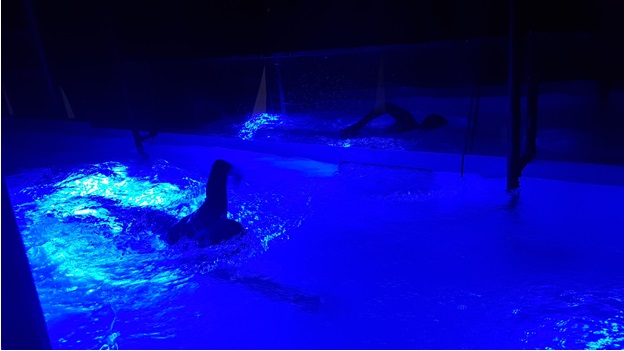CHANGES IN BIOMECHANICAL VARIABLES DURING 200-M FRONT CRAWL ON LOWER LIMB IN THAI NATIONAL SWIMMERS
Main Article Content
Abstract
Purpose: The purpose of this study was to determine the changes in biomechanical variables during 200-M front crawl on a lower limb in male Thai national swimmer.
Methods: Seven male Thai national front crawl swimmers who participated in the 29th SEA GAMES in Malaysia, 2017 volunteered for this study. Changes in biomechanical variables of 200-M front crawl on a lower limb were recorded in the swimming flume. Where the participants were asked to swim at 75% of the maximum 200-M front crawl speed in the swimming pool. The analysis were divided into 4 laps, which were 20-40 m, 70-90 m, 120-140 m, and 170-190 m. The differences in mean values of joint angles and joint velocities were compared using one-way repeated measure ANOVA at the significant level of .05.
Results: Overall, the biomechanical variables of a lower limb, including attacking body angle, the angles of ankle joint, knee joint, and hip joint, and the velocities of ankle joint, knee joint, and hip joint were statistically different across 4 phases during a 200-M front crawl swim (all, P<.05). As the swimming distance increased, the attacking body angle decreased white the angles of ankle joint, knee joint, and hip jointed increased.
Conclusion: These findings indicated that biomechanical variables of lower limb change as a function of swimming distance during a 200-M front crawl.
Article Details

This work is licensed under a Creative Commons Attribution-NonCommercial-NoDerivatives 4.0 International License.
References
Callaway, A.J. (2015). Measuring Kinematic Variables in Front Crawl Swimming Using Accelerometers: A Validation Study. Sensors, 15(5), 11363-11386.
Chainok, P., Nakkanueng, H., Sowhasun, I., and Matjiur, R. (2020). Analysis of Specific Pacing Strategy of the 200M and Individual Medley Swimmers in the 45th Thailand National Game. Journal of Sports Science and Health, 21(2), 207-221.
Chengalur, S. N., & Brown, P. L. (1992). An analysis of male and female Olympic swimmers in the 200-meter events. Canadian journal of sport sciences, 17(2), 104-109.
Chollet, D., Chalies, S., & Chatard, J. C. (2000). A new index of coordination for the crawl: description and usefulness. International journal of sports medicine, 21(1), 54-59.
de Jesus, K., de Jesus, K., Figueiredo, P., Gonçalves, P., Vilas-Boas, J.P., and Fernandes, R.J. (2011). LOWER LIMBS JOINTS MOTION DURING SUBMAXIMAL 100-M BUTTERFLY. Paper presented at the ISBS-Conference Proceedings Archive.
Deschodt, V., Arsac, L., and Rouard, A. (1999). Relative contribution of arms and legs in humans to propulsion in 25-m sprint front-crawl swimming. European Journal of Applied Physiology and Occupational Physiology, 80(3), 192-199.
Deschodt, V.J., and Arsac, L.M. (2004). Morning vs. evening maximal cycle power and technical swimming ability. The Journal of Strength & Conditioning Research, 18(1), 149-154.
Figueiredo, P., Rouard, A., Vilas-Boas, J.P., and Fernandes, R.J. (2013). Upper-and lower-limb muscular fatigue during the 200-m front crawl. Applied Physiology, Nutrition, and Metabolism, 38(7), 716-724.
Gatta, G., Cortesi, M., and Di Michele, R. (2012). Power production of the lower limbs in flutter-kick swimming. Sports Biomechanics, 11(4), 480-491.
Maglischo, C., Maglischo, E., Higgins, J., Hinricks, R., Luedtke, D., Schleihauf, R., and Thayer, A. (1986). A biomechanical analysis of the 1984 US Olympic swimming team: The distance freestylers. Journal of Swimming Research, 2(3), 12-16.
McLeod, I. (2010). Swimming anatomy. Human Kinetics Champaign, IL.
Strzała, M., Krężałek, P., Kaca, M., Głąb, G., Ostrowski, A., Stanula, A., and Tyka, A. (2012). Swimming speed of the breaststroke kick. Journal of human kinetics, 35(1), 133-139.

